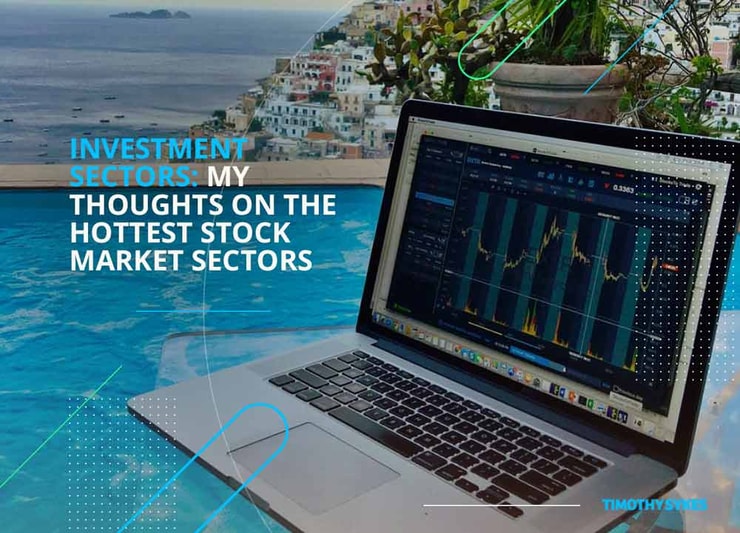If you’re interested in the stock market, understanding how investment sectors work — and which are more desirable — can play to your favor. After all, you want to know how and when you can potentially make the most money.
Certain investment sectors fall in and out of favor all the time. For instance, during the 2008 financial crisis, many real estate stocks took headers. The same thing goes for auto companies that had to be bailed out.
Real estate and automotive are just two investment sectors out of many. Here, I’ll share with you my opinions on these sectors and which of the stock market sectors are hottest right now.
Table of Contents
What Are Investment Sectors?

A sector, in some ways, is just another way of saying “industries.” In the finance industry, however, investment sectors refer to the specific delineations between different types of stocks and securities. Healthcare, energy, pharmaceuticals, and tech are just a few examples of investment sectors.
The reason we divide investments into sectors is that each has a different risk profile associated with it. Some stocks are inherently more risky than others. Plus, many analysts like to specialize. Someone who’s an expert on energy stocks might provide commentary and advice exclusively on energy securities.
Additionally, stocks don’t exist in a vacuum. They’re part of a larger market. That’s why analysts and other professionals in the securities industry evaluate sectors as well as individual stocks. For example: Instead of saying GM’s stock increased by X percent, we could say that the automobile sector increased by X percent.
What is a Sector Fund?
A sector fund is a mutual fund or other type of fund that pools securities from only on sector. If you believe that an entire sector will rise in value over time, you might invest in a mutual fund or exchange-traded fund (ETF) devoted to that industry.
In many cases, sector funds are considered less risky because you’re not relying on one company to fuel the investment. Even if one stock goes down in price, its compatriots can make up for those losses and mitigate your risk of losing money.
Of course, it doesn’t always work out that way. There aren’t any guarantees. Retail might be really hot one month, then swing low the next, which could affect an entire sector fund.
The Influence of Tax Reform on Investment Sectors
The recent tax reforms, put into place by President Trump, could result in an upswing in the stock market. The tax cuts resulted in record highs in the stock market, which could prove valuable for investors moving forward.
Changing the sectoral balance, however, could have unpredictable impacts on the stock market and other securities, so it’s important not to rely exclusively on this development.
Examples of High-Level Investment Sectors

Individual sectors, such as utilities and telecommunications, are divided into four primary economic sectors. Each sector represents part of the economy.
Technically, there are actually five economic sectors — the last one reserved for government and industry decision-makers — but the top four are the ones that will probably concern you.
Primary Sector
The first or primary investment sector focuses on commodities — not the market, but the products.
Companies related to mining, agriculture, and similar endeavors fall into this category. It’s often called the raw materials sector because it relates to natural products.
Animal husbandry also belongs to the primary sector, as do forestry and crop management.
If you can grow, raise, or harvest the product, the company behind it belongs in this investment sector.
Secondary Sector
The secondary sector deals with manufacturing and other aspects of industry. It’s considered secondary because it often uses materials produced in the primary sector to create a finished product.
For instance, a logging company would belong in the primary sector. The furniture company that uses that wood to make tables and chairs would fall into the secondary sector.
Other industries that belong in this sector include construction products and processes, supply chain companies, and the warehousing industry.
Tertiary Sector
Companies and industries in the tertiary sector provide services. These are the businesses that clean carpets, manage your marketing endeavors, provide consulting, and more.
The secondary sector supports this sector by providing the finished products with which these companies provide their services.
Labor is just one facet of the tertiary sector. Also included are companies and industries that provide advice, experience, and guidance. Additionally, services like transportation and hospitality fall under this umbrella.
Quaternary Sector
Our final sector, the quaternary sector, is all about information services. This is the innovative sector.
Companies that operate here have a significant level of education and experience behind them, and they’re generally tasked with making new advancements to help a culture grow.
Scientists, information technology companies, and educational companies all belong here. They’re tasked with sharing information or using it to create more opportunities for industry.
Examples of Depressed Market Sectors
A depressed market sector is one that is suffering from low volume, volatility, and prices. In other words, the stocks have declined in price, few traders are active, and the decline remains steady.
In most cases, investment sectors get depressed for extended periods of time.
Take energy, for instance. There are plenty of arguments to be made for excellent energy investments (which I’ll get to below), but there’s no denying the impact of oil prices on this sector. When crude oil goes down, oil and gas companies and their counterparts start to struggle.
Telecommunications is another depressed market sector. There’s no doubt that cable-cutters have influenced the economy, preferring to stream their entertainment at leisure than to subscribe to an expensive cable or dish service. While mobile growth remains strong, other elements of the telecom sector have been hit hard by technological advancements and consumer confusion.
The reality, though, is that even a depressed market sector doesn’t need to impact your trading by a significant degree, especially if you’re into penny stocks or day trading. You’re looking for individual opportunities.
Plus, depressed markets present opportunities for shorting stocks and benefiting from price declines. It all depends on how well you’re able to time your trades relative to the market movement.
Top Sectors to Invest in Right Now

If you’re looking for good stocks to consider for future investments, start with the investment sectors themselves. Following are my thoughts on the hottest stock market sectors.
Information Technology
There’s no doubt that information technology is one of the hottest investment sectors due to the constant innovation in this space. The obvious stock to consider is, of course, Apple, but it’s not the only game in town.
Consider, for instance, the manufacturing companies that make components for Apple’s iPhone or for virtual reality technology. Thousands of companies are involved in the making of these products, but you won’t know their names unless you do your research.
There’s always a race in this industry to come up with the next big thing. Paying attention to the smaller companies that are hungry and making names for themselves can pay off.
Consumer Discretionary
Over the last few years, we’ve seen people spend lots more money on vacations, adventure experiences, sporting events, and leisure activities.
Instead of spending discretionary funds on the biggest television or a new treadmill for the basement, consumers want to get out in the world and discover new things.
Consequently, stocks in the consumer discretionary stock market sector can be touch and go. Hospitality, travel, gambling, recreation, and food services can sometimes provide good opportunities for stock market plays.
If you follow me on Instagram (@TimothySykes), you might notice that I catalogue my own travels there.** I’m not the only one. Lots of people, from Millennials to baby boomers, have the urge to get out of their homes and explore the world. International stock markets might offer opportunities for investors who want to go that route.
Financials Sector Funds
The financials sector took a big hit post-2008 because of new regulatory oversight and stress tests that required banks and other financial institutions to mitigate risk and provide more protection for consumers. Some of those stressors are going away, so financials sector funds could be worth a look for investors.
I’m predicting some mergers and acquisitions in this sector through the end of 2018 and beyond.
Don’t just throw your money into a fund, though. Research it carefully to decide whether it offers the right balance of risk and reward for your particular trading strategy.
Utilities
You might start to see that investment sectors overlap. For instance, utilities are heavily dependent on energy, which I’ll get to below. Crude oil price drops can put huge pressure on utilities, especially in areas where demand exceeds availability.
I don’t recommend putting money in utilities unless you find a stock that has a huge catalyst behind a predicted upswing. Monitoring the markets using a trading platform like StocksToTrade can help you find these opportunities.
Real Estate
Competition is fierce in real estate right now, which is why many retail real estate investment trusts (REITs) aren’t performing very well. However, REITs with properties in affluent and highly trafficked areas will always make money — which doesn’t mean their stocks will continually go up. It all depends on sentiment.
Despite the rapid growth of the e-commerce market, people still shop in brick-and-mortar stores. In many parts of the country, new commercial and residential developments continue to go up at lightning-fast paces as demand in desirable communities outpaces supply.
Health Care Sector Funds
The biggest growth I see in health care sector funds relates to technology-aided health care.
For instance, companies that create high-tech devices, such as wearables, for more efficient diagnostics and monitoring might provide good sector fund investments. It all depends on sentiment and catalysts, though, especially for day traders.
Consumer Staples
Lots of people assume they can safely invest in consumer staples stocks because, after all, staples are things we need. Companies in this space make toilet paper, food products, soap, and toothbrushes.
However, if you walk down the aisle at your local supermarket, you’ll notice that you don’t see just one toothbrush on the aisle. There are dozens from multiple companies.
Furthermore, sentiment is leaning more toward consumer staples that have small carbon footprints. In the packaged foods industry, consumers want whole foods, organic foods, and healthy foods.
Paying attention to these trends can help you invest more wisely in various investment sectors.
Energy
I already touched on energy, but want to mention a few more things about it …
Energy doesn’t just mean crude oil. It also means hydroelectric energy, solar power, and other alternative fuel sources. Furthermore, you have to consider regions. Sentiment is heavily biased toward U.S.-based production as well as domestic fracturing.
Energy is one of those sectors where you have to do even more research than you would for other investment sectors. You know that I’m always telling you to do your homework, but that’s doubly true if you want to invest in energy, especially if you’re inclined toward speculative stocks.
How to Choose Which Sector to Invest In

I’m not biased toward any one sector. I’m more focused on individual stocks and how they’re performing within specific windows of time. That’s how I make the majority of my profits. I’m looking for recognizable patterns to repeat so I can dip buy or short a stock based off a pump and dump.
However, that doesn’t mean I don’t pay attention to investment sectors and monitor their performance. If you’d like to focus your investments on a single sector, you need some foundation for monitoring that sector’s performance.
When should you invest? When should you steer clear? Focusing on research and knowledge will help you make more informed plays.
- Technical and fundamental analysis of the stock market: Follow the charts and pay attention to news. Know what’s happening in that sector.
- Pick the right stocks and their appropriated sectors: Don’t just assume that good sector performance correlates to good stock performance. That’s not always true.
- Evaluate liquidity and price: It always boils down to liquidity and price. Are there enough shares trading in the market? Does the price movement indicate a favorable outcome for your trade?
- Consider the ones that tend to bloom late: Picking a speculative stock within a well-performing sector can work to your advantage because fewer people are watching these companies.
Master Your Skills With the Trading Challenge
If you’re serious about investing in the stock market and reaching your goals, apply to join my Trading Challenge.
I don’t give my students fish — I teach them how to fish. There are no guarantees in the stock market, which means that I lose on trades just like everyone else. My goal is to help make those losses less likely by teaching you what to look for when you’re analyzing potential plays — and what to avoid.
Plus, you get to learn from my millionaire students who have done the work and continue to trade daily to increase their wealth.**
The Bottom Line

I don’t necessarily advocate trading based on specific investment sectors, but knowledge is essential in the stock market. I want you to know as much about Wall Street as possible so you can spot the good plays from a mile away.
Learning about investment sectors teaches you how sentiment, catalysts, and news influence entire industries and how those factors can set up potentially good plays for your portfolio.
Even in a recession, certain stocks perform well. If you can find those, you can trade in any economic climate.
That’s my goal for you. Pretend you’re a retired trader, just looking for the best plays, regardless of whether you’re confining yourself to a single sector.
Do you have a favorite investment sector?




Leave a reply